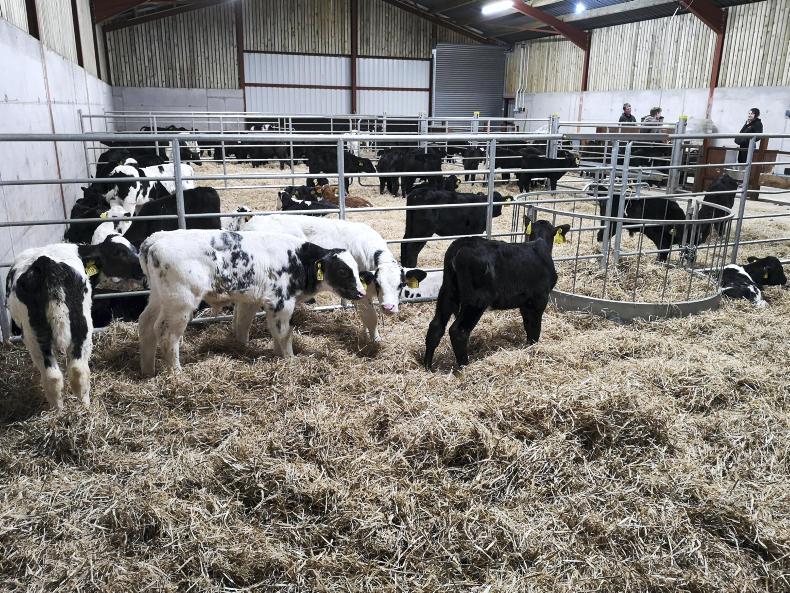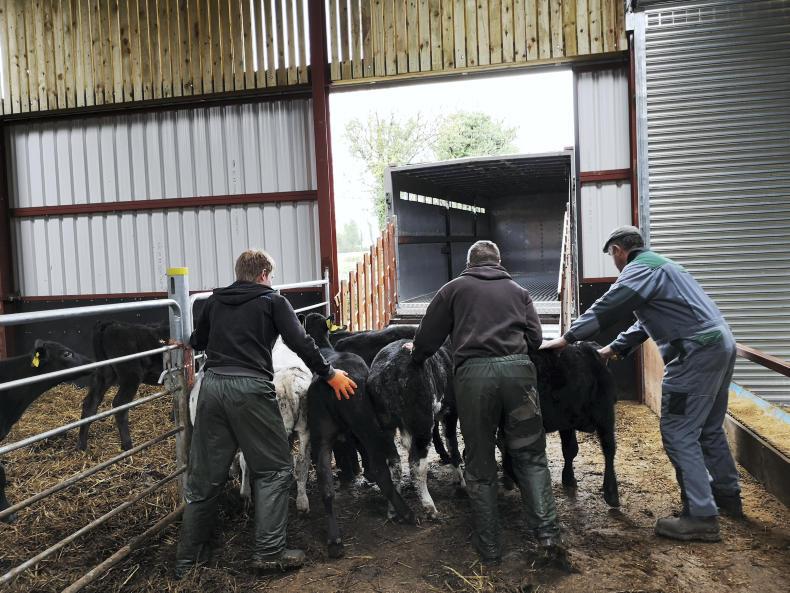Back in December, we filled our new calf house for the first time. It has now been emptied and filled again.
The calves are contract-reared through the Blade Farming system. The theory is that they come to us at about three weeks of age and stay here for approximately 12 weeks before moving to a beef finisher. The house is then washed out and filled again.
The first batch of calves came just before Christmas, which probably wasn’t ideal, but the second batch came in the middle of lambing season, so it was from bad to worse. However, after a few very busy weeks all are settled in now.
The calves are a mixture of Aberdeen Angus and Blue calves and also a mixture of bulls and heifers. They are all from dairy herds and are brought here directly from other farms.
It’s a completely new enterprise for myself and the boys, and it has been a steep learning curve.
Upon arrival, the calves have to be EID tagged and trained to use the milk machine. The next day we have to weigh and vaccinate them, and follow that up at a later stage with booster vaccines and a coccidiosis drench. We also have to de-horn anything that needs it and the vet will come out and do the castrations.
The rest of the work is mainly feeding and bedding. It is not overly strenuous, but it is constant.
Important
However, one thing that is definitely required is good stockmanship skills. It is vital that you walk the house often and take time to observe the calves, and if there is a sick animal to treat it promptly.

Inside the new calf-rearing shed on the Egerton farm.
It got me thinking back to the time I went to Greenmount Agricultural College. I learned a lot there when I was paying attention, but the one thing they could not teach you in the classroom was that stockmanship skills are something that must be learned on the job.
Some people are natural at working with stock and others can learn to become reasonable at it. But some will just never have that ability.
In my opinion, you must have a passion for livestock and you must be able to bond with animals.
Ambition
This enterprise was started on the farm to help ensure that my sons could follow their ambitions to become farmers.
At this stage I am very proud of the way they have taken it on and the level of stockmanship that they are showing after such a short space of time
I didn’t really know if they would be able to cope, managing the new enterprise on their own.
However, at this stage I am very proud of the way they have taken it on and the level of stockmanship that they are showing after such a short space of time.
At the start I was walking after them, double-checking everything, but now I am taking a back seat and only helping out if they need me.
Weaning
The first batch of calves looked really well when they were on milk, but around weaning the bloom went off them and they looked a little plainer. But once they started to eat a fair bit of meal they picked up again.
When they were batched into their different groups for moving to the next farms, they were very impressive looking.
Beef
I have heard people saying that you can’t get beef from the dairy herd, but this is a complete myth. I am convinced that the calves that left our farm will go on to make good beef cattle.
I know that it is going against the grain for a suckler farmer to be rearing dairy breed calves, but needs must. If we can take a by-product from the dairy industry and turn it into something viable, then why not?
Lessons learned
There are a couple of things that I have learned from this experience. Firstly, I can trust my sons and let them carry on with the work (they are more than capable).
It is time to change the “them and us” mentality between farmers and processors
But perhaps the most important lesson is that things work best when everyone involved in the supply chain pulls together.
We, in the suckler industry, need to form relationships all the way down the supply chain to the consumer. It is time to change the “them and us” mentality between farmers and processors, and for us all to work together for the future of our industry. We need each other.
Read more
The ups and downs of spring calving
New enterprise adds to business' income
Back in December, we filled our new calf house for the first time. It has now been emptied and filled again.
The calves are contract-reared through the Blade Farming system. The theory is that they come to us at about three weeks of age and stay here for approximately 12 weeks before moving to a beef finisher. The house is then washed out and filled again.
The first batch of calves came just before Christmas, which probably wasn’t ideal, but the second batch came in the middle of lambing season, so it was from bad to worse. However, after a few very busy weeks all are settled in now.
The calves are a mixture of Aberdeen Angus and Blue calves and also a mixture of bulls and heifers. They are all from dairy herds and are brought here directly from other farms.
It’s a completely new enterprise for myself and the boys, and it has been a steep learning curve.
Upon arrival, the calves have to be EID tagged and trained to use the milk machine. The next day we have to weigh and vaccinate them, and follow that up at a later stage with booster vaccines and a coccidiosis drench. We also have to de-horn anything that needs it and the vet will come out and do the castrations.
The rest of the work is mainly feeding and bedding. It is not overly strenuous, but it is constant.
Important
However, one thing that is definitely required is good stockmanship skills. It is vital that you walk the house often and take time to observe the calves, and if there is a sick animal to treat it promptly.

Inside the new calf-rearing shed on the Egerton farm.
It got me thinking back to the time I went to Greenmount Agricultural College. I learned a lot there when I was paying attention, but the one thing they could not teach you in the classroom was that stockmanship skills are something that must be learned on the job.
Some people are natural at working with stock and others can learn to become reasonable at it. But some will just never have that ability.
In my opinion, you must have a passion for livestock and you must be able to bond with animals.
Ambition
This enterprise was started on the farm to help ensure that my sons could follow their ambitions to become farmers.
At this stage I am very proud of the way they have taken it on and the level of stockmanship that they are showing after such a short space of time
I didn’t really know if they would be able to cope, managing the new enterprise on their own.
However, at this stage I am very proud of the way they have taken it on and the level of stockmanship that they are showing after such a short space of time.
At the start I was walking after them, double-checking everything, but now I am taking a back seat and only helping out if they need me.
Weaning
The first batch of calves looked really well when they were on milk, but around weaning the bloom went off them and they looked a little plainer. But once they started to eat a fair bit of meal they picked up again.
When they were batched into their different groups for moving to the next farms, they were very impressive looking.
Beef
I have heard people saying that you can’t get beef from the dairy herd, but this is a complete myth. I am convinced that the calves that left our farm will go on to make good beef cattle.
I know that it is going against the grain for a suckler farmer to be rearing dairy breed calves, but needs must. If we can take a by-product from the dairy industry and turn it into something viable, then why not?
Lessons learned
There are a couple of things that I have learned from this experience. Firstly, I can trust my sons and let them carry on with the work (they are more than capable).
It is time to change the “them and us” mentality between farmers and processors
But perhaps the most important lesson is that things work best when everyone involved in the supply chain pulls together.
We, in the suckler industry, need to form relationships all the way down the supply chain to the consumer. It is time to change the “them and us” mentality between farmers and processors, and for us all to work together for the future of our industry. We need each other.
Read more
The ups and downs of spring calving
New enterprise adds to business' income







 This is a subscriber-only article
This is a subscriber-only article









SHARING OPTIONS: